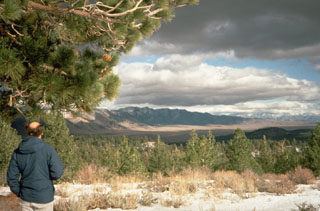Report on Long Valley (United States) — May 1990
Bulletin of the Global Volcanism Network, vol. 15, no. 5 (May 1990)
Managing Editor: Lindsay McClelland.
Long Valley (United States) S moat seismicity declines and deformation slows
Please cite this report as:
Global Volcanism Program, 1990. Report on Long Valley (United States) (McClelland, L., ed.). Bulletin of the Global Volcanism Network, 15:5. Smithsonian Institution. https://doi.org/10.5479/si.GVP.BGVN199005-323822
Long Valley
United States
37.7°N, 118.87°W; summit elev. 3390 m
All times are local (unless otherwise noted)
Earthquakes continued to occur in the S moat, but at a declining rate following the 6-7 May swarm. About 80 earthquakes of magnitude greater than or equal to 2 occurred 6-13 May, but the number of events of that magnitude declined to nine for the week of 14-21 May, then seismicity fluctuated between three and six magnitude greater than or equal to 2 shocks/week through mid-June. The only M 3 event in the region through 11 June occurred in the Chalfant Valley aftershock zone (40 km SE of the caldera) on 21 May. Repeated trilateration measurements, spanning the caldera with the 2-color geodimeter, showed a gradual slowing of the episode of accelerated extension across the S moat and resurgent dome that began in September 1989.
Geological Summary. The large 17 x 32 km Long Valley caldera east of the central Sierra Nevada Range formed as a result of the voluminous Bishop Tuff eruption about 760,000 years ago. Resurgent doming in the central part of the caldera occurred shortly afterwards, followed by rhyolitic eruptions from the caldera moat and the eruption of rhyodacite from outer ring fracture vents, ending about 50,000 years ago. During early resurgent doming the caldera was filled with a large lake that left strandlines on the caldera walls and the resurgent dome island; the lake eventually drained through the Owens River Gorge. The caldera remains thermally active, with many hot springs and fumaroles, and has had significant deformation, seismicity, and other unrest in recent years. The late-Pleistocene to Holocene Inyo Craters cut the NW topographic rim of the caldera, and along with Mammoth Mountain on the SW topographic rim, are west of the structural caldera and are chemically and tectonically distinct from the Long Valley magmatic system.
Information Contacts: D. Hill, USGS Menlo Park.

